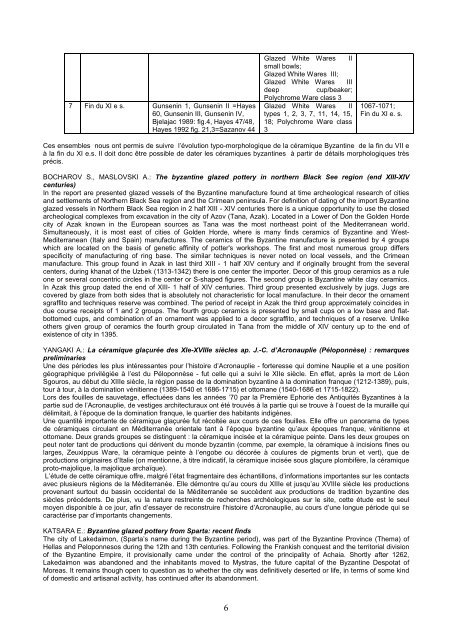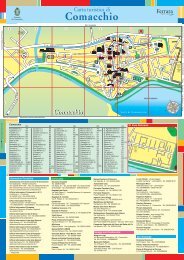Abstracts - Archeologia Medievale Venezia
Abstracts - Archeologia Medievale Venezia
Abstracts - Archeologia Medievale Venezia
Create successful ePaper yourself
Turn your PDF publications into a flip-book with our unique Google optimized e-Paper software.
7 Fin du XI e s. Gunsenin 1, Gunsenin II =Hayes<br />
60, Gunsenin III, Gunsenin IV,<br />
Bjelajac 1989: fig.4, Hayes 47/48,<br />
Hayes 1992 fig. 21,3=Sazanov 44<br />
6<br />
Glazed White Wares II<br />
small bowls;<br />
Glazed White Wares III;<br />
Glazed White Wares III<br />
deep cup/beaker;<br />
Polychrome Ware class 3<br />
Glazed White Wares II<br />
types 1, 2, 3, 7, 11, 14, 15,<br />
18; Polychrome Ware class<br />
3<br />
1067-1071;<br />
Fin du XI e. s.<br />
Ces ensembles nous ont permis de suivre l’évolution typo-morphologique de la céramique Byzantine de la fin du VII e<br />
à la fin du XI e.s. Il doit donc être possible de dater les céramiques byzantines à partir de détails morphologiques très<br />
précis.<br />
BOCHAROV S., MASLOVSKI A.: The byzantine glazed pottery in northern Black See region (end XIII-XIV<br />
centuries)<br />
In the report are presented glazed vessels of the Byzantine manufacture found at time archeological research of cities<br />
and settlements of Northern Black Sea region and the Crimean peninsula. For definition of dating of the import Byzantine<br />
glazed vessels in Northern Black Sea region in 2 half XIII - XIV centuries there is a unique opportunity to use the closed<br />
archeological complexes from excavation in the city of Azov (Tana, Azak). Located in a Lower of Don the Golden Horde<br />
city of Azak known in the European sources as Tana was the most northeast point of the Mediterranean world.<br />
Simultaneously, it is most east of cities of Golden Horde, where is many finds ceramics of Byzantine and West-<br />
Mediterranean (Italy and Spain) manufactures. The ceramics of the Byzantine manufacture is presented by 4 groups<br />
which are located on the basis of genetic affinity of potter's workshops. The first and most numerous group differs<br />
specificity of manufacturing of ring base. The similar techniques is never noted on local vessels, and the Crimean<br />
manufacture. This group found in Azak in last third XIII - 1 half XIV century and if originally brought from the several<br />
centers, during khanat of the Uzbek (1313-1342) there is one center the importer. Decor of this group ceramics as a rule<br />
one or several concentric circles in the center or S-shaped figures. The second group is Byzantine white clay ceramics.<br />
In Azak this group dated the end of XIII- 1 half of XIV centuries. Third group presented exclusively by jugs. Jugs are<br />
covered by glaze from both sides that is absolutely not characteristic for local manufacture. In their decor the ornament<br />
sgraffito and techniques reserve was combined. The period of receipt in Azak the third group approximately coincides in<br />
due course receipts of 1 and 2 groups. The fourth group ceramics is presented by small cups on a low base and flatbottomed<br />
cups, and combination of an ornament was applied to a decor sgraffito, and techniques of a reserve. Unlike<br />
others given group of ceramics the fourth group circulated in Tana from the middle of XIV century up to the end of<br />
existence of city in 1395.<br />
YANGAKI A.: La céramique glaçurée des XIe-XVIIIe siècles ap. J.-C. d’Acronauplie (Péloponnèse) : remarques<br />
preliminaries<br />
Une des périodes les plus intéressantes pour l’histoire d’Acronauplie - forteresse qui domine Nauplie et a une position<br />
géographique privilégiée à l’est du Péloponnèse - fut celle qui a suivi le XIIe siècle. En effet, après la mort de Léon<br />
Sgouros, au début du XIIIe siècle, la région passe de la domination byzantine à la domination franque (1212-1389), puis,<br />
tour à tour, à la domination vénitienne (1389-1540 et 1686-1715) et ottomane (1540-1686 et 1715-1822).<br />
Lors des fouilles de sauvetage, effectuées dans les années ’70 par la Première Ephorie des Antiquités Byzantines à la<br />
partie sud de l’Acronauplie, de vestiges architecturaux ont été trouvés à la partie qui se trouve à l’ouest de la muraille qui<br />
délimitait, à l’époque de la domination franque, le quartier des habitants indigènes.<br />
Une quantité importante de céramique glaçurée fut récoltée aux cours de ces fouilles. Elle offre un panorama de types<br />
de céramiques circulant en Méditerranée orientale tant à l’époque byzantine qu’aux époques franque, vénitienne et<br />
ottomane. Deux grands groupes se distinguent : la céramique incisée et la céramique peinte. Dans les deux groupes on<br />
peut noter tant de productions qui dérivent du monde byzantin (comme, par exemple, la céramique à incisions fines ou<br />
larges, Zeuxippus Ware, la céramique peinte à l’engobe ou décorée à coulures de pigments brun et vert), que de<br />
productions originaires d’Italie (on mentionne, à titre indicatif, la céramique incisée sous glaçure plombifère, la céramique<br />
proto-majolique, la majolique archaïque).<br />
L’étude de cette céramique offre, malgré l’état fragmentaire des échantillons, d’informations importantes sur les contacts<br />
avec plusieurs régions de la Méditerranée. Elle démontre qu’au cours du XIIIe et jusqu’au XVIIIe siècle les productions<br />
provenant surtout du bassin occidental de la Méditerranée se succèdent aux productions de tradition byzantine des<br />
siècles précédents. De plus, vu la nature restreinte de recherches archéologiques sur le site, cette étude est le seul<br />
moyen disponible à ce jour, afin d’essayer de reconstruire l’histoire d’Acronauplie, au cours d’une longue période qui se<br />
caractérise par d’importants changements.<br />
KATSARA E.: Byzantine glazed pottery from Sparta: recent finds<br />
The city of Lakedaimon, (Sparta’s name during the Byzantine period), was part of the Byzantine Province (Thema) of<br />
Hellas and Peloponnesos during the 12th and 13th centuries. Following the Frankish conquest and the territorial division<br />
of the Byzantine Empire, it provisionally came under the control of the principality of Achaia. Shortly after 1262,<br />
Lakedaimon was abandoned and the inhabitants moved to Mystras, the future capital of the Byzantine Despotat of<br />
Moreas. It remains though open to question as to whether the city was definitively deserted or life, in terms of some kind<br />
of domestic and artisanal activity, has continued after its abandonment.





